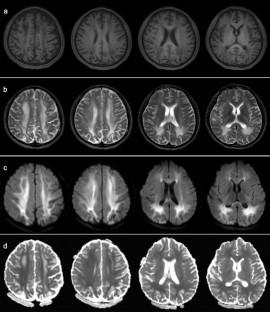Journal of Neurology ( IF 4.8 ) Pub Date : 2023-05-10 , DOI: 10.1007/s00415-023-11760-9
Meng-Wen Wang 1 , Chu-Jun Wu 2, 3 , Zai-Qiang Zhang 2, 3

|
Objectives
Phenylketonuria (PKU) is the most prevalent congenital disease of amino acid metabolism. Neurological manifestations usually complicate PKU in untreated adult patients. This study describes neurological and imaging phenotypes of adult patients with untreated PKU.
Methods
We investigated a cohort of 320 unrelated adult patients with suspected genetic leukoencephalopathies using whole-exome sequencing (WES). We analyzed the phenotypic features of adult PKU patients in our cohort and summarized cases reported in the literature.
Results
We identified 10 patients in our cohort and 12 patients in the literature, who presented with neurological manifestations and were diagnosed with PKU in adulthood. Approximately 60% of these patients had onset of clinical features in adulthood. The most common neurological symptoms of patients presenting in adulthood were cognitive disturbance and spastic paralysis, followed by vision loss, cerebellar ataxia, weakness of limbs, and seizure. This differed from that of patients presenting with PKU features in childhood, who consistently had mental retardation with various neurological complications emerging during a broad age range. Imaging findings were similar between patients presenting with clinical features in childhood compared with adulthood, comprising symmetric periventricular white matter hyperintense on T2-weighted imaging and diffusion-weighted imaging predominantly in the parietal and occipital lobes. Also, normal brain imaging and diffuse leukoencephalopathies were observed in both patient groups.
Conclusion
PKU with clinical features presenting in adulthood is an atypical subtype and should be considered during diagnosis of adults with neurological symptoms and leukoencephalopathy. DWI seems to be most helpful to distinguish patients with PKU. Additionally, we demonstrate that PKU constitutes a part (3.1%) of adult genetic leukoencephalopathies.
中文翻译:

未经治疗的苯丙酮尿症成人的神经学和影像学表型:新病例和文献综述
目标
苯丙酮尿症(PKU)是最常见的氨基酸代谢先天性疾病。对于未经治疗的成年患者,神经系统表现通常会使 PKU 复杂化。本研究描述了未经治疗的 PKU 成年患者的神经学和影像学表型。
方法
我们使用全外显子组测序 (WES) 对 320 名疑似遗传性白质脑病的无关成年患者进行了研究。我们分析了队列中成年 PKU 患者的表型特征,并总结了文献中报道的病例。
结果
我们在队列中确定了 10 名患者和文献中的 12 名患者,这些患者出现神经系统表现并在成年后被诊断为 PKU。这些患者中大约 60% 在成年期出现临床特征。成年期患者最常见的神经系统症状是认知障碍和痉挛性麻痹,其次是视力丧失、小脑性共济失调、四肢无力和癫痫发作。这与童年时期表现出 PKU 特征的患者不同,后者始终存在智力低下,并在广泛的年龄范围内出现各种神经系统并发症。与成年期相比,儿童时期出现临床特征的患者的影像学结果相似,包括 T2 加权成像和弥散加权成像上对称的脑室周围白质高信号,主要出现在顶叶和枕叶。此外,两组患者均观察到正常的脑成像和弥漫性白质脑病。
结论
具有成年期临床特征的 PKU 是一种非典型亚型,在诊断患有神经系统症状和白质脑病的成人时应予以考虑。DWI 似乎最有助于区分 PKU 患者。此外,我们证明 PKU 构成成人遗传性白质脑病的一部分(3.1%)。































 京公网安备 11010802027423号
京公网安备 11010802027423号